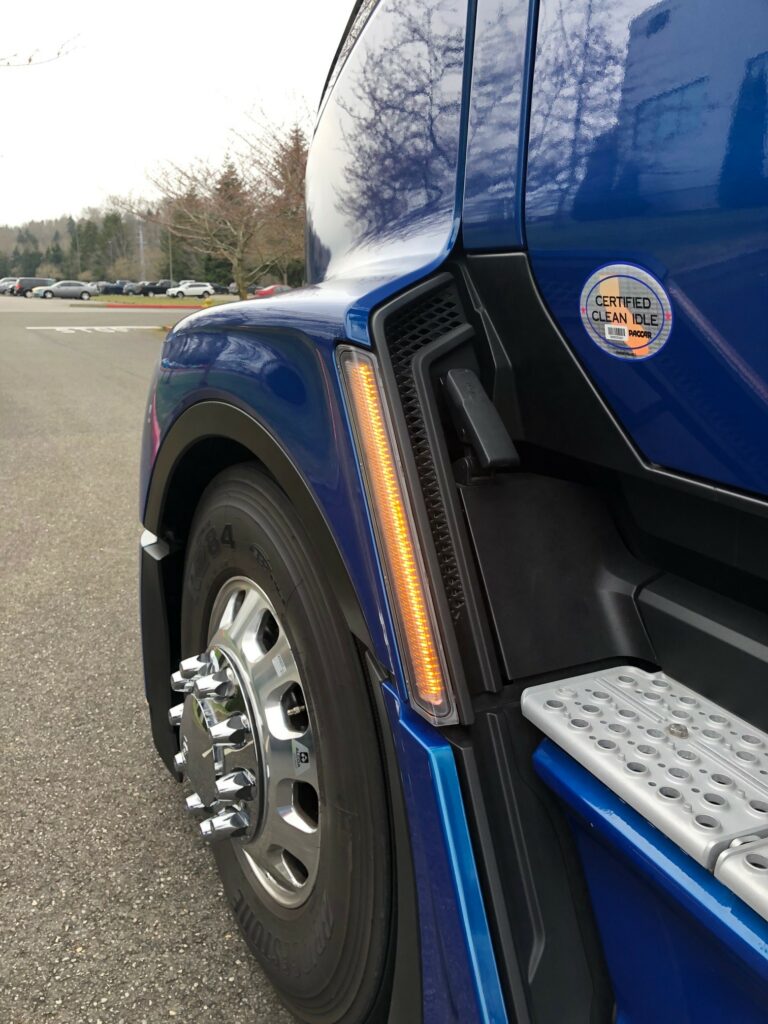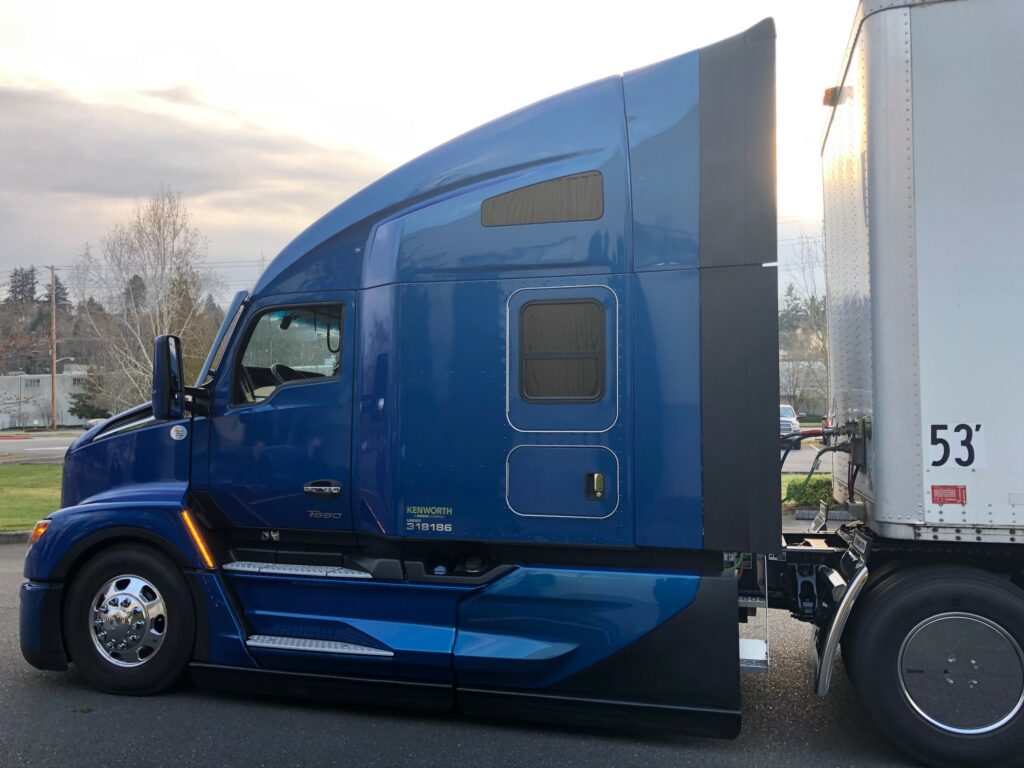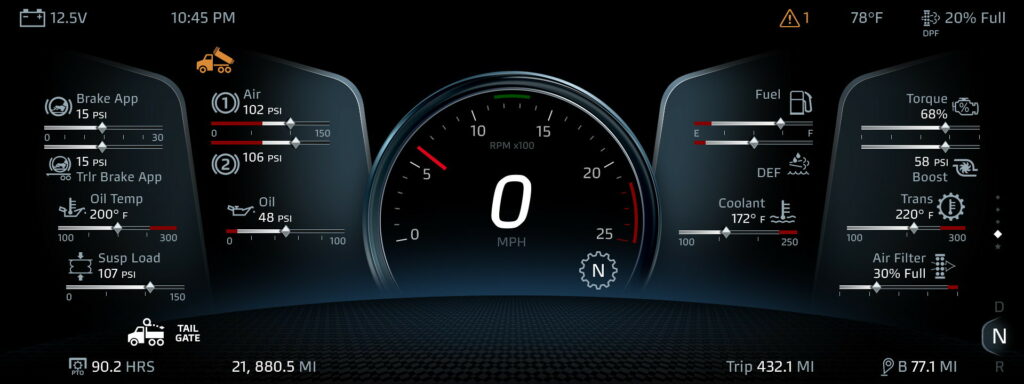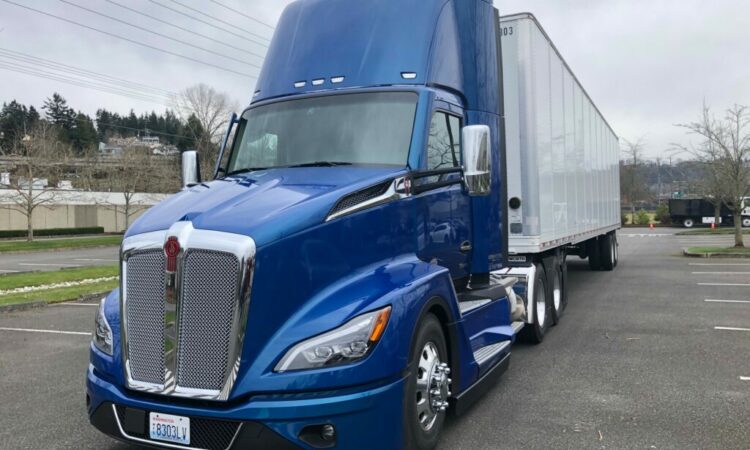I remember the first time I saw a Kenworth T680. It was back in 2012 on the floor of the Mid-America Truck Show in Louisville, Ky. The new T680s were tricked out in a “Lamborghini gold” paint scheme and looked impossibly sleek and modern at the same time. Inside the new Kenworths were driver-focused cabs and sleepers with new creature comforts and safety-focused vehicle systems pointing the way toward a whole new era in trucking.
I remember the first time I saw a Kenworth T680. It was back in 2012 on the floor of the Mid-America Truck Show in Louisville, Ky. The new T680s were tricked out in a “Lamborghini gold” paint scheme and looked impossibly sleek and modern at the same time. Inside the new Kenworths were driver-focused cabs and sleepers with new creature comforts and safety-focused vehicle systems pointing the way toward a whole new era in trucking.
Well, that new era in trucking – with increasing amounts of advanced technology focused on vehicle and fleet safety – is unquestionably here. And, if you figure the average Class 8 truck has about a 20-year shelf life, it seems reasonable that Kenworth decided it was time to freshen up the T680 and take advantage of all the new vehicle and powertrain systems available today.
I’ve always felt that Kenworth does an exceptionally nice job of blending that old, “classic” American long-nosed truck with the sleek, modern lines required to deliver optimal fuel economy. So, if you’re a fan of the T680’s look and stance, there’s no need to panic.
Kenworth engineers have taken a fairly restrained approach to the exterior of the new truck, which they’ve officially dubbed the 2021 Next Generation T680. In fact, it takes a fairly practiced eye to pick out of lot of what they’ve done to the hood and fender-lines on the updated model.
But, in essence, they’ve smoothed out lines and crafted new, cleaner pathways for air to move over the front of the truck and down its sides, thanks to new fairings, an astoundingly low ground clearance and new fifth-wheel and tandem-axle fairings. That’s in addition to a new aerodynamic bumper and hood, turning vanes, durable lower fairing extensions, chassis fairings, wheel well closeouts, 28-inch side extenders, tandem drive axle fairings, and wheel cover. All of these enhancements are laser-focused on keeping the airflow as close to the truck’s cab as possible to reduce drag-causing turbulence.
All told, according to Kenworth design director Jonathan Duncan, these subtle changes to the truck’s front profile delivered an impressive 6% fuel economy increase over the previous-generation T680 with a comparably spec’d Paccar MX-13 diesel engine. That is welcome news for fleets and drivers pushing the fuel efficiency envelope out past 10 mpg in their operations today.
Duncan says the new hood on the Next Generation T680 is eight inches narrower than the previous version of the truck. But it’s not apparent when you’re looking the new T680 over. The overall stance and demeanor of the truck appear virtually unchanged.
To my eye, the most noticeable new “cool” features on the truck are narrow, brightly lit, vertical accent lighting located on the trailing edge of the front fenders, just ahead of the cab doors. These new lights look sharp while the truck is cruising down the highway. But there’s more to them than just looks. The lights are perfectly situated from a height and blind-spot perspective to serve as highly noticeable turn indicators, specifically designed to give the truck an added measure of safety when changing lanes or turning in heavy traffic situations with lots of four-wheeler passenger cars in the mix.
The fenders themselves are now lower than on the previous version of the T680, to better channel air over and around the steps into the cab. And borrowing a little super car technology, there’s also a passive-pressure vent behind the wheel wells to let crosswinds through, lessening any lateral forces on the truck as it cruises down the highway.
The chassis fairings have been redesigned to be more aerodynamic – but also much easier to access without tools. A simple, easy-to-find-and-toggle lever actuates a flip-down access panel to the battery compartment. And while the fairings seem to ride awfully low for full aerodynamic performance, Duncan says they’re been designed from new composite materials to absorb and deflect impacts from curbs, debris and other road hazards without taking any damage.
Underneath all of this is a much-improved chassis packaging arrangement, Duncan says, which allowed Kenworth engineers to decrease the T680’s wheelbase, providing a smoother ride with fewer vibrations as well as allowing reduced trailer gaps from 38 to 42 inches with new sleeper side extensions helping tame this notoriously difficult aerodynamic area while still allowing easy access to the truck’s frame.

Information and Safety
To get a full, in-depth, feel for everything the Next Generation T680 has to offer, Kenworth was kind enough to fly me out to its headquarters in Renton, Washington, just outside of Seattle for a briefing and an extended test drive in the new truck.
My test rig for the day was spec’d for serious longhaul work, with a 76-inch high-roof sleeper berth in a “Deep Cerulean” blue paint scheme and the “Driver’s Studio” sleeper package, which includes amenities like swiveling passenger seats, dinner table and TV mount, as well as the premium audio system. To say the truck’s interior was plush is an understatement. It featured sumptuous leather seats – “black with Madrona Accents, according to the spec’ sheet – and Kenworth’s “Diamond VIT” top-line interior trim package. In short, the interior looked great and smelled fantastic.
Under the hood sat a 405-horsepower Paccar MX-13 diesel engine mated to a Paccar 12-speed automated manual transmission. The truck featured the full suite of Kenworth aerodynamic features and was tripping the scales at 67,000 lb. All in all, a perfectly reasonable example of how this model trick would be fitted out and run in the real world.
Getting into the Next Generation T680’s cab is a safe snap, thanks to ample, sturdy and ergonomically placed grab-handles both inside and outside of the truck. And once you’re in the seat, the excellent interior layout of the seat, steering wheel and mirror controls make quick work of settling in and getting situated for a day out on the road.
Turning the key switch, located to the left of the steering wheel, fired up the MX-13 up front, which quickly settled into a quiet rumble while it warmed up – an introduction to the noise abatement work Kenworth engineers have put into this cab structure to minimize powertrain and road noise.
A quick scan of the dash reveals a somewhat sparse display if you remember the busy old dashboards of yore, with banks of dials, gauges and switches. But before you can dwell on the lack of gauges, the new Kenworth, 15-inch Digital Display Screen in the center instrument cluster comes brilliantly to life, complimented by the familiar Nav+ Infotainment screen located in the center dashboard.
The Digital Display Screen features crisp, vibrant colors and a full suite of easily customizable gauges and an incredible amount of vehicle and situational information that can be accessed in an instant with a mere sweep of your eyes. Brian Lindgren, director of research and development at Kenworth, told me there’s been a lot of discussion about the new display screen because it is such a striking departure from traditional truck dashboards. But, he noted, that once drivers got familiar with the screen and how it functions, the feedback has been overwhelmingly positive.
The screen can quickly be set up to display as much – or as little – vehicle information as you desire. A rolling toggle wheel on the steering wheel controls, lets you quickly expand or collapse the display screen to your liking with your thumb. And in case of a problem, the screen flashes any alerts to you in a quickly recognizable message, which can then easily be dismissed to cut down on distractions until you’re able to address the matter.

A Technological tour de force
Our preplanned route out of Renton would take us east toward Maple Valley, Washington, before cutting down to the south and picking up I-405 heading back toward Seattle. It was a nice little mix of two-lane backroads, country highways and full-blown Interstates that gave me a chance to experience the Next Generation T680 across its full operational spectrum.
Paccar is clearly sold on the performance and fuel economy of its MX-13 diesel engine. And once you’re driving with one up in front of you, it’s easy to see why. Even with 67,000 lb. behind it, the 405-horspower engine had no trouble getting the rig up to speed quickly, quietly and efficiently.
The Paccar 12-speed automated transmission is as solid a gearbox as any heavy-duty truck transmission on the road today. And there’s no question it helps make driving the T680 a smoother and safer experience by providing silky hands-off shifts at exactly the right times to keep the big truck rolling down the highway.
In fact, taken as a whole, the Next Generation T680 has an almost automotive feel to it, at times – as if you’re behind the wheel of a large, luxury SUV, and not in a Class 8 truck hauling a loaded 53-foot trailer down the road behind you.
Thanks to the narrow, sharply sloping front hood, views out and around the Next Generation T680 are outstanding. But as we got out of the Seattle traffic and onto a quieter stretch of country roads, I found myself captivated by the 15-inch Digital Display Screen and the host of advanced vehicle safety systems that Paccar engineers have so effectively integrated into it.
The Paccar Automated Transmission featured Predictive Cruise Control with Neutral Coast Capability, complemented by the new Lane Keep Assist with Torque Assisted Steering system. There’s also the Kenworth’s Lane Departure Warning system, which combats lane drift due to fatigue and distractions. And the Kenworth Collision Mitigation system, which detects when the truck may be about to collide with another vehicle or object, and then alerts and assists the driver by taking pre-emptive braking action – when necessary –to avoid or reduce severity of a collision.
The final piece to this new, integrated safety system is the Kenworth’s Side Object Detection system, which continuously monitors the passenger side of the truck, and provides the driver with audible and visual alerts when an object or vehicle has entered certain zones.
Thanks to all of these systems constantly helping the driver keep track of what’s going on around them, the truck feels amazingly safe, even in heavy traffic. Even more remarkable is how efficiently all of the information taken in, processed and acted upon by these systems is presented to the driver via the new 15-inch Digital Display Screen in the dash.

It took me about an hour to familiarize myself with the dash screen layout and understand how and where various bits of information were being displayed. But once I got the gist of it, I was fascinated by the amount of information that was readily available to me at a mere glance: The speed of the car in front of you? The closing distance in seconds between you? The posted speed limit? Your pre-set cruise speed? Your lane orientation? Your RPMs? The tachometer “sweet spot” for optimal fuel economy? All of that information – and so much more – is right there in front of you to access quickly and easily and act upon as needed – along with your fuel, DEF, battery, coolant and other critical information.
There were a couple of other cool features on the truck that Duncan pointed out as well. The first was the preset speed limiter, which functions as a complimentary system on the Kenworth Predictive Cruise Control. When the cruise control is on, you can quickly use a couple of Up/Down buttons on the steering wheel to dial in a desired vehicle speed. And once that speed is selected, the transmission will not allow the truck to exceed it, either in cruise control, or while you’re actively on the throttle
It’s a great feature for small towns or construction zones, because you can quickly set your top speed, and then there’s no worrying about getting a ticket because you got distracted, were moving along with the traffic flow or simply forgot how fast you were supposed to be going. It’s a great safety tool that delivers peace of mind in potentially tricky traffic situations as well.
The other new, cool, system on the truck is the Lane Keep Assist with Torque Assisted Steering system. This is essentially a “smart,” electronic control boost to the truck’s hydraulic power steering system, using electronic control systems to actively adjust steering inputs to best counter various driving situations.
For example, when you’re at very low speeds, or backing up, and the system eases torque feedback from the power steering system, allowing faster, more accurate lock-to-lock steering inputs and response. As the truck begins to go faster, the system then adds more torque to the steering response, so the driver has a better, tighter, feel for the road and can drive with precision at highway speeds and when changing lanes or tackling long curves.
As slick as this system is, Kenworth has taken things one step further by adding a torque input selector switch, located to the right of the steering wheel on the dashboard. The switch has three settings, which allows drivers to pick a steering feel which is the most natural for them, from a rather loose low setting, up to a significantly stiffer feel in the third position. I tried the system on all three settings, and found them all to be perfectly fine, before setting it on the highest position – since I’ve always personally like a good, tight-handling vehicle.
The new T680 is definitely a “Next Generation” truck for Kenworth, and one that builds nicely on its existing reputation. The truck is a technological tour de force that offers something for everyone in fleet operations today. Fleet owners will love the new aerodynamic package and the fuel economy numbers it delivers. And fleet executives and drivers alike will benefit from a truck that uses technology so efficiently to make it so much easier to be safe while out in chaotic road conditions.
Spec’ Box: 2021 Kenworth T680
- Configuration: 76” High Roof Sleeper
- Engine: Paccar MX-13 diesel
- Transmission: Paccar 12-speed Automated Transmission
- Front axle: Meritor MFS12E+ 12.5k Std Track
- Front suspension: Taperleaf Lightweight 12.5K
- Rear axle: Paccar Axle 40K Dual, STD Track
- Rear suspension: AG400L 40K Dual 52″ AS
- Driver assistance features: Predictive Cruise Control/Neutral Coast, NAV+ HD, TruckTech+, Lane Keeping Assist with Torque Assisted Steering


